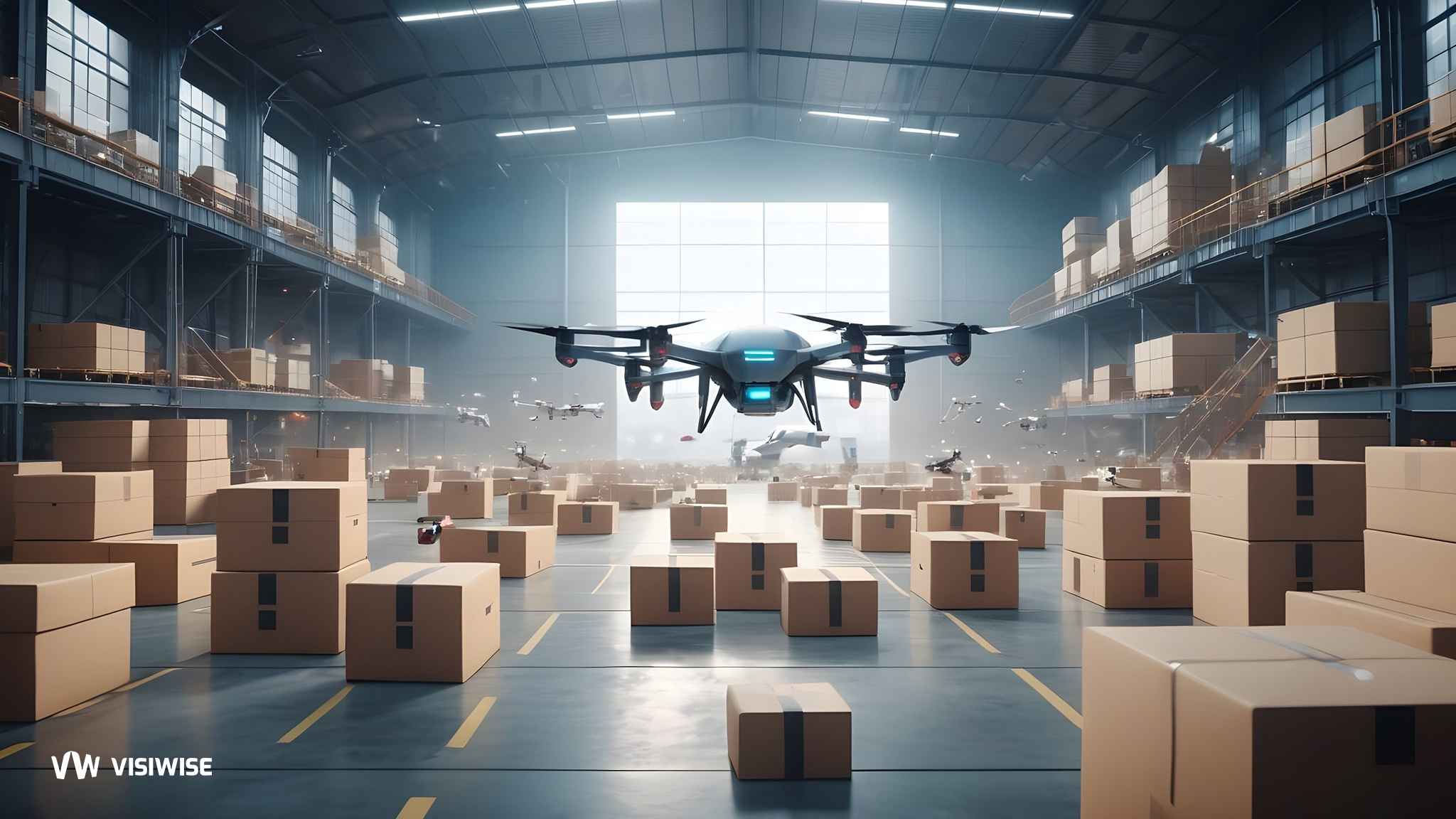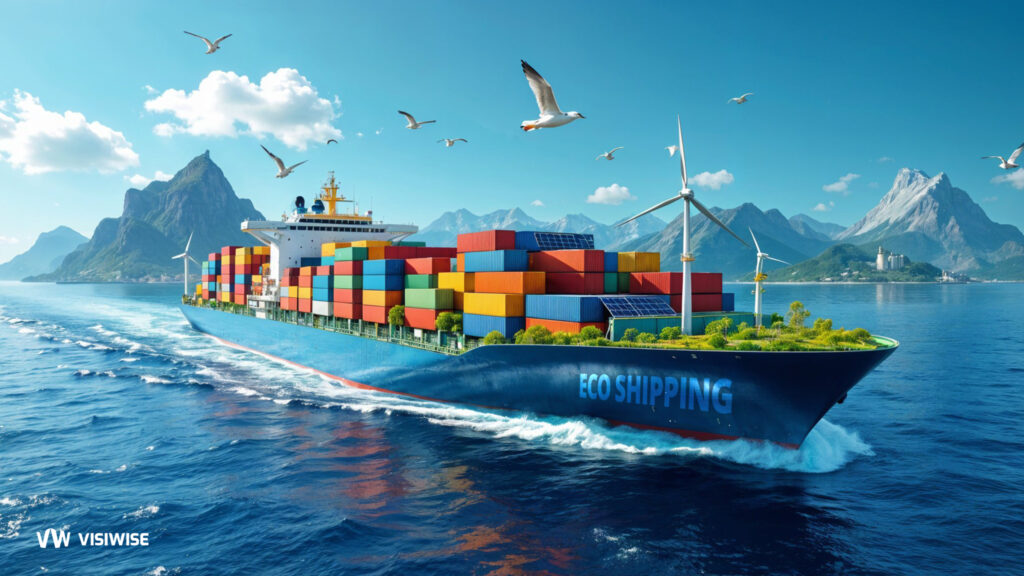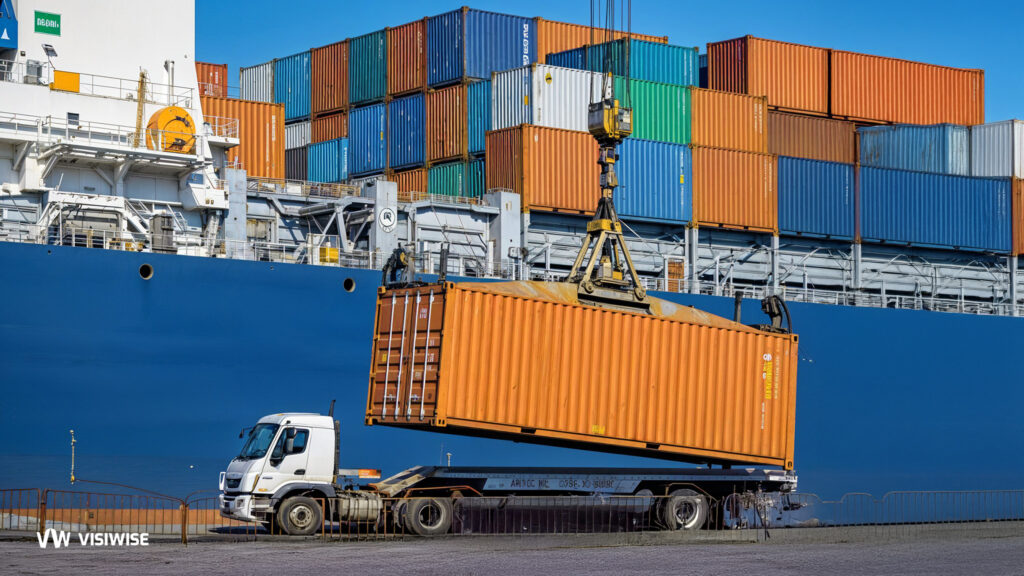Artificial Intelligence (AI) has become deeply ingrained in our society, revolutionizing various aspects of our lives. From predictive text completion to drone deliveries by companies like Amazon, and even automated grocery services, AI showcases its remarkable potential to enhance efficiency across different domains.
In addition to its impact on daily life, AI has significantly transformed the business landscape across multiple sectors. Particularly in supply chain management and logistics, AI has emerged as a transformative force. McKinsey’s report forecasts that by 2030, AI will usher in a new era of logistics, surpassing human capabilities in repetitive yet crucial tasks. Given the current challenges in shipping, the demand for advanced logistics technologies is more pressing than ever.
Let’s explore the key advantages of integrating Artificial Intelligence into logistics.
How it impacts the logistics industry?
The vision of packages effortlessly finding their fastest route to their destination is one many of us eagerly anticipate. While that day may not be immediate, the transformation AI brings to the logistics industry is profound and multi-faceted. Once reliant on handwritten or typed lists and manual tasks, AI has propelled the logistics sector into a streamlined machine where predictive accuracy reigns supreme. This shift from traditional, manual, and time-consuming processes to automated, efficient, and predictive actions is unmistakable.
Challenges of Logistics Without AI
Traditionally, logistics has been a complex, manual industry, with approximately two-thirds of warehouse operations driven by manual processes. This reliance on manual labor has led to various challenges:
- Package Delays and Disruptions: Unexpected breakdowns and weather conditions often result in significant delays in the logistics chain, with 53% of merchants reporting package delays in 2021.
- Inefficient Route Planning: Without AI, logistics companies must rely on manual, static route planning that fails to adapt to real-time changes in traffic or weather conditions. This can result in longer transit times and increased fuel costs, with traffic congestion alone costing the industry $74.5 billion annually.
- Lack of Supply Chain Visibility: Managing a supply chain without the predictive capabilities of AI is akin to sailing in the dark. Forty-four percent of supply chain executives lack the end-to-end visibility necessary to proactively manage disruptions.
- Inefficiencies and Errors: Without automated systems, executing intricate tasks becomes time-consuming and error-prone. Warehouses lose approximately 3,000 hours per year due to overdue and manual processes, highlighting the inefficiencies of a manual logistics system.
Logistics Transformed by AI
The integration of AI has brought about a remarkable transformation in the logistics landscape. According to a Statista report, the market value of AI in logistics and supply chains surged to USD 1.3 billion in 2020. Furthermore, data indicates that 38% of logistics companies actively embraced AI, resulting in operational cost reductions of up to 50%.
AI Addressing Traditional Challenges
- Cost Reduction and Safety Enhancement: Warehouses equipped with AI can slash operation costs by 50% while improving safety measures by 90%.
- Handling Potential Delays: AI empowers logistics operations to anticipate and address potential delays through predictive analysis.
- Optimized Delivery Routes: AI algorithms optimize delivery routes, saving valuable time and fuel.
- Predictive Capabilities: AI’s predictive capabilities enable proactive preparation for unforeseen disruptions, facilitating better planning.
- Automation for Efficiency: AI automates complex tasks, enhancing operational efficiency and accuracy.
In essence, the introduction of AI into logistics has revolutionized the industry, with projections indicating that by 2035, AI will elevate logistics productivity by over 40%. It has effectively tackled persistent challenges that impede efficiency, paving the way for smoother operations and demonstrating the profound impact of intelligent technology on the sector.
8 AI Use Cases in Logistics
As AI continues to reshape the logistics landscape, its application across various domains is evident. Let’s delve into eight key areas where AI has made significant strides:
1. Automated Warehousing
AI-driven robots are revolutionizing warehousing operations by handling tasks such as sorting and transportation traditionally done by humans. Machine learning algorithms optimize space usage and predict future demand patterns, while computer vision technology enhances inventory management precision.
2. Demand Forecasting
AI enhances demand forecasting by incorporating diverse variables like weather patterns and regional events, resulting in highly accurate predictions. Its continuous learning capabilities refine forecasts over time, transforming demand forecasting from guesswork to data-driven science.
3. Predictive Maintenance and Damage Detection
AI analyzes sensor data to predict equipment breakdowns preemptively, reducing unplanned downtime. Additionally, AI-powered computer vision detects damages in goods, ensuring quick resolution and minimizing losses.
4. Stock Level Optimization
AI dynamically adjusts stock levels based on predictive analytics, reducing overstocks and stock-outs. This optimization enhances operational efficiency and customer satisfaction while minimizing costs.
5. Supply Chain Optimization
AI streamlines supply chain processes through intelligent demand forecasting, dynamic route planning, predictive maintenance, and improved supplier relationship management, making operations more efficient and resilient.
6. Dynamic Pricing
AI analyzes real-time market trends, competitor pricing, and customer behavior to adjust prices dynamically, optimizing sales and profits. Over time, AI’s precision in pricing improves, ensuring optimal pricing strategies.
7. Route Optimization
AI optimizes delivery routes by analyzing factors like traffic patterns and road conditions, minimizing travel time and costs. Real-time adjustments ensure efficient last-mile deliveries with documented efficiency gains of up to 30%.
8. Automating Document Processing
AI automates document processing through OCR and NLP technologies, speeding up data entry, reducing errors, and streamlining workflow. This results in significant time and cost savings while improving operational efficiency.
Other Key Advantages of AI Integration in Logistics
Enhancing Data Quality
The foremost advantage of employing AI in logistics lies in its ability to enhance the quality of data. AI technologies such as Natural Language Processing (NLP) and Machine Learning (ML) play a pivotal role in accurately capturing and organizing the vast volumes of information inundating logistics firms on a daily basis. NLP can comprehend terms, phrases, and industry-specific jargon, while ML can establish connections between these data points, thereby creating contextual understanding and evolving with the language.
With increasingly robust global connectivity, AI can achieve higher levels of accuracy, particularly when applied to logistics, facilitating optimal utilization of shipping data. By mitigating risks and devising more efficient solutions, AI optimizes resource allocation and reduces costs. Through the collaboration between human expertise and machine capabilities, enriched data empowers companies to determine precise staffing and asset requirements, duration of deployment, and location considerations, even across multiple sites.
By enhancing the authenticity and consolidation of information, logistics enterprises gain deeper insights, enabling them to make necessary refinements across all facets of their operations to meet the demands of a rapidly evolving landscape.
Improved Predictive Analytics
In the past, logistics planners relied heavily on manual assessments, often resorting to pen and paper. Despite years of experience and intuition, ensuring optimization solely through human efforts is increasingly challenging in today’s complex environment. Analyzing data, estimating capacities, and conducting network analyses present daunting tasks for the human mind, especially considering the time-intensive nature of these processes. Moreover, the complexity escalates during peak periods or as companies expand.
Harnessing AI for Enhanced Predictive Analytics
AI-powered solutions offer a breakthrough in addressing these challenges. By utilizing more accurate data and incorporating relevant external factors, AI can execute logistics procedures with unparalleled efficiency. This includes better estimation of upcoming demand, enabling logistics technology firms to adopt a proactive approach.
For instance, industry leader DHL utilizes AI and predictive analytics to monitor over eight million online and social media posts, identifying potential supply chain disruptions. Leveraging Machine Learning (ML) and Natural Language Processing (NLP), the platform extracts insights from online conversations, detecting material shortages, access issues, and supplier statuses. With the ability to anticipate future challenges accurately, logistics companies can stay ahead of the demand curve, gaining a competitive advantage and minimizing unnecessary costs.
Enhanced Logistics Forecasting
The integration of AI technologies promises to revolutionize logistics forecasting, with projections indicating a potential productivity increase of over 40% by 2035. This forecast is particularly significant amidst the explosive growth of E-commerce, which surged by 33% to $792 billion in 2021 alone.
AI-Driven Predictive Capabilities
The ability to predict asset requirements with precision is now more critical than ever. AI can seamlessly tap into diverse databases across the transportation network, aggregating information on available resources and opportunities, thereby offering a roadmap to enhanced operational feasibility.
Advanced Demand Forecasting
AI-powered software enables demand forecasting on a granular level, projecting requirements for various asset types and locations up to 12 weeks in advance. This foresight empowers logistics companies to optimize rail and vehicle routes, streamline storage for ocean shipments, and proactively address potential bottlenecks at ports or areas prone to production delays.
Navigating Chaotic Transportation Landscapes
Amidst the turbulence within the transportation industry, exemplified by the historic stoppage at the ports of Los Angeles and Long Beach, AI emerges as a crucial tool for mitigating disruptions. Satellite imagery reveals that shortages of truckers, shipping containers, and other critical equipment have led to ships waiting offshore for access to port facilities, exacerbating delays along the supply chain.
Strategic Asset Positioning
In the dynamic landscape of logistics, where the cost of shipping a standard 40-foot container from China to the east coast of the US surged to over $20,000 in 2021, up from less than $3,000 just two years prior, optimizing asset utilization becomes paramount.
Enhanced Visibility and Strategic Deployment
AI analysis offers invaluable insights into fleet performance, enabling planners and logistics professionals to strategically position assets and mitigate unnecessary risks. Through sophisticated algorithms, companies can leverage predictive capacity matching, minimizing the transit of empty containers and trailers while optimizing vehicle deployment.
Optimized Linehaul and Last-Mile Planning
The rapid growth of E-commerce and home delivery in 2021 saw a staggering 24.3% increase in the parcel and last-mile segment of transportation. In response, logistics companies must move beyond subjective guesswork and embrace AI-driven linehaul planning to refine and elevate their operations.
Leveraging AI for Complex Transport Networks
Transport networks are inherently intricate, posing challenges in supply chain optimization. AI harnesses shipment data to provide invaluable insights, enabling companies to optimize fleet utilization while considering user requirements and business constraints. These advancements facilitate automated logistics scheduling, enhancing overall functionality and ensuring efficient transportation from linehaul to last-mile delivery.
Granular Predictive Capabilities
AI’s predictive capabilities extend to forecasting forthcoming volumes at a granular level, allowing for meticulous planning at every stage of a shipment’s journey. This is particularly critical in last-mile planning, where service levels are paramount. By comprehensively analyzing external factors that may impact shipment progress, AI empowers logistics firms to navigate potential roadblocks efficiently, particularly in the last mile of transportation. Leveraging AI-driven linehaul planning enables companies to demonstrate real-time adaptability and reliability, setting them apart in the competitive landscape.
Implementing AI in Logistics: Large Corporations and Startups
Amazon
Amazon, a leading global e-commerce giant, leverages AI to improve various facets of its logistics operations. AI algorithms contribute to precise demand forecasting and efficient inventory management. Moreover, Amazon employs AI in its automated warehouse systems, utilizing robots for tasks such as picking, packing, and sorting items, thereby enhancing efficiency and minimizing errors. Notably, Amazon deploys approximately 200,000 robots across its warehouses. Additionally, the company is experimenting with drone deliveries and autonomous trucks, both of which rely on AI for optimization and safety.
FedEx
FedEx utilizes AI to automate and enhance parcel sorting processes within its hubs. AI-enabled robots have the capability to sort up to 1,200 parcels per hour, resulting in a substantial reduction in sorting time. Moreover, FedEx employs AI for predictive analytics to anticipate potential delivery delays caused by weather disruptions or traffic congestion, thereby augmenting the overall customer experience
Nuro
Nuro is revolutionizing logistics and last-mile delivery through its AI-powered fully autonomous vehicles. Founded by two former Google engineers, Nuro is at the forefront of leveraging AI to redefine local commerce. By focusing on unmanned deliveries, Nuro spearheads a shift towards environmentally friendly, efficient, and safer logistics practices, mitigating human-driven delivery errors, traffic congestion, and carbon emissions. This exemplifies the transformative potential of AI in revolutionizing traditional logistics models.
ClearMetal
ClearMetal harnesses robust AI-driven predictive analytics to address long-standing inefficiencies within the shipping industry. Through its AI algorithms, ClearMetal adeptly tracks, predicts, and manages the intricate dynamics of container logistics. This enables the elimination of unnecessary costs associated with mismanaged goods, underutilized shipping containers, and idle assets. As a result, ClearMetal serves as a compelling demonstration of AI’s ability to transform data into actionable insights, ultimately leading to significant cost savings in logistics.
GreyOrange
GreyOrange’s advanced AI-powered robots serve as exemplary case studies in revolutionizing warehouse and fulfillment center operations. By integrating robotics with machine learning, GreyOrange’s automated systems excel in picking, sorting, and packing goods with unparalleled accuracy and speed, surpassing human capabilities. Automating these repetitive tasks not only minimizes human error and expedites delivery timelines but also empowers human operators to concentrate on strategic initiatives. This underscores the role of AI in enhancing the efficiency and intelligence of logistics operations.
Challenges in Adopting AI
While AI holds great promise for the logistics sector, its integration presents various challenges. Among these are:
Cost
The acquisition, integration, and maintenance of AI systems can be financially burdensome. Many companies find the initial investment prohibitively high, particularly smaller firms struggling to secure budget approval. This includes costs associated with acquiring hardware, software, and expertise. However, as AI becomes more prevalent, costs are gradually decreasing. Research indicates that AI implementation in logistics can lead to significant cost reductions, potentially up to 50%.
Integration with Legacy Systems
Established logistics companies often operate with legacy IT systems and processes, complicating the integration of advanced AI solutions. This integration process can be both complex and time-consuming, with the extent of required infrastructure changes frequently underestimated. Companies must possess the necessary expertise to effectively incorporate AI alongside existing tools.
Finding the Right Talent
A shortage of skilled personnel in areas such as machine learning, data science, and AI development presents a significant challenge for logistics firms. Recruiting the expertise needed for AI implementation is not straightforward, and existing employees may require extensive retraining and upskilling to effectively collaborate with AI systems.
Managing Organizational Change
The adoption of AI requires substantial alterations to operations, roles, and corporate culture, which can be daunting for firms. This transition management process may serve as a deterrent to embracing AI, as employees might exhibit resistance due to misconceptions about its implications. However, effectively communicating the benefits and offering comprehensive training can facilitate a smoother transition to adoption.
Signs Your Logistics Company is Ready to Utilize AI
Determining if your logistics company is prepared to embrace AI can be challenging but can be gauged by observing certain indicators. Here are some signs:
- Persistent Cost Challenges: If the company frequently faces high costs due to inefficiencies in its current system.
- Regular Delays: Frequent delays caused by inefficient route planning and a lack of real-time data analysis.
- Difficulty Adapting to Market Changes: Struggling to swiftly adapt to fluctuating market conditions.
- Manual Operations: Tasks like picking, packing, and shipping heavily rely on manual efforts, leading to operational inefficiencies.
- Inaccurate Demand Prediction: Difficulty in accurately predicting demands and market trends, impacting overall productivity.
If these issues resonate with your logistics company, it might be primed for AI integration to address these challenges effectively.
Final Thought
In conclusion, the integration of AI in logistics is not just a technological upgrade but a strategic imperative. By leveraging AI’s capabilities in areas like automated warehousing, demand forecasting, and route optimization, companies can achieve significant operational efficiencies and cost savings. However, to fully realize these benefits, firms must address challenges such as high costs, legacy system integration, talent shortages, and organizational change management. Overcoming these hurdles will be key to unlocking AI’s full potential and staying competitive in the rapidly evolving logistics landscape.



